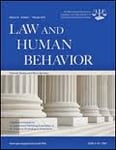 Overall, eyewitness identification performance is poor; however, the sequential procedure used in the field reduces the identification of known-innocents, but the differences are relatively small. This is the bottom line of a recently published article in Law and Human Behavior. Below is a summary of the research and findings as well as a translation of this research into practice.
Overall, eyewitness identification performance is poor; however, the sequential procedure used in the field reduces the identification of known-innocents, but the differences are relatively small. This is the bottom line of a recently published article in Law and Human Behavior. Below is a summary of the research and findings as well as a translation of this research into practice.
Featured Article | Law and Human Behavior | 2015, Vol. 39, No. 1, 1-14
 Double-Blind Photo Lineups Using Actual Eyewitnesses:
An Experimental Test of a Sequential Versus Simultaneous Lineup Procedure
Double-Blind Photo Lineups Using Actual Eyewitnesses:
An Experimental Test of a Sequential Versus Simultaneous Lineup Procedure
Author
Gary L. Wells, Iowa State University
Nancy K. Steblay, Augsburg College
Jennifer E. Dysart,
John Jay College of Criminal Justice
Abstract
Eyewitnesses (494) to actual crimes in 4 police jurisdictions were randomly assigned to view simulta-neous or sequential photo lineups using laptop computers and double-blind administration. The sequen-tial procedure used in the field experiment mimicked how it is conducted in actual practice (e.g., using a continuation rule, witness does not know how many photos are to be viewed, witnesses resolve any multiple identifications), which is not how most lab experiments have tested the sequential lineup. No significant differences emerged in rates of identifying lineup suspects (25% overall) but the sequential procedure produced a significantly lower rate (11%) of identifying known-innocent lineup fillers than did the simultaneous procedure (18%). The simultaneous/sequential pattern did not significantly interact with estimator variables and no lineup-position effects were observed for either the simultaneous or sequential procedures. Rates of nonidentification were not significantly different for simultaneous and sequential but nonidentifiers from the sequential procedure were more likely to use the “not sure” response option than were nonidentifiers from the simultaneous procedure. Among witnesses who made an identification, 36% (41% of simultaneous and 32% of sequential) identified a known-innocent filler rather than a suspect, indicating that eyewitness performance overall was very poor. The results suggest that the sequential procedure that is used in the field reduces the identification of known-innocent fillers, but the differences are relatively small.
Keywords
eyewitness identification, sequential lineups, eyewitness error, eyewitness field experiments, lineup position effects
Summary of the Research
The general American population has experienced a burgeoning awareness over the past 33 years with regard to the unreliability of eyewitness identification evidence. Empirical research has highlighted problems with eyewitness identification causing procedural reform across states, such as New Jersey, Connecticut, Texas, Florida, and North Carolina, as well as within individual law enforcement agencies.
This study conducted a field experiment to examine what is said to be the most controversial system reform, the sequential lineup. “A sequential procedure is one in which the witness views lineup members one at a time and makes a decision on each before seeing the next. This contrasts with a simultaneous procedure in which all lineup members are available to be viewed at the same time. The sequential procedure was devised originally to prevent witnesses from making ‘relative judgments’ in which witnesses compare lineup members with each other and then show a propensity to identify the person who looks most like their memory of the culprit relative to the other members of the lineup” (p. 2).
This experiment was conducted utilizing specific techniques that had been previously implemented within jurisdictions that currently utilize the sequential lineup to accurately reflect how it is conducted in actual practice. “This included back-loading, using the continuation rule, permitting witnesses to resolve their own multiple picks, permitting a second sequential viewing if the witness requested it, and permitting a ‘not sure’ option” (p.3).
Results from this study found that “the sequential procedure produced a lower rate of filler identifications (known innocent individual) than did the simultaneous procedure but also a lower rate of identifying the suspect. Only the difference in filler rates was statistically significant. Less than 16% of sequential witnesses requested a second lap (a second viewing of the line-up) and only 6.4% of sequential witnesses made a consequential change in their identification decision with a second lap. Including these relatively rare second laps had little effect on the pattern of results” (p. 10).
Translating Research into Practice
“The current field experiment addresses the question of what happens when actual witnesses to serious crimes view lineups using a simultaneous procedure versus a sequential procedure that is actually used in the field (which is not exactly the procedure used in all lab studies). This is an important issue because a large number of law enforcement agencies in the U.S. now use a sequential lineup procedure (e.g., Connecticut, North Carolina, and New Jersey as well as major cities such as Dallas and Boston). A 2011 survey of law enforcement agencies in the U.S. indicated that 32% use a sequential procedure.
A second purpose of this field experiment was to collect the first data with eyewitnesses to actual crimes using procedures that are double-blind, guarantee uniformity of prelineup instructions (via automation), randomize the position of the suspect in the lineups, and guarantee that every witness response is fully documented” (p. 2).
This study highlights issues that lay within eyewitness identification. “Specifically, both the current study and lab studies show that (a) witnesses are less likely to make an identification with the sequential procedure, and that (b) witnesses are less likely to identify a filler with the sequential” (p. 10). Law enforcement agencies, attorneys, judges, clinicians and even lay jurors can benefit from being aware of inaccuracies that may arise when conducting eyewitness identification lineups as well as the lower chances of misidentification that has been found among sequential lineups compared to simultaneous. It is also important that the aforementioned parties all take note of the failure amongst law enforcements agencies to document nonidentification lineup to ensure fair procedural due process.
“Moreover, recent work shows that giving eyewitnesses an explicit ‘don’t know’ option reduces errors (both incorrect identifications as well as incorrect rejections) with no significant reduction in accurate identification rates” (p.11).
This study found that individuals were more likely to utilize a “don’t know” option in a sequential line up than a simultaneous. “With the simultaneous procedure 81% of the nonidentifications were rejections and only 19% were ‘not sure’ responses. In contrast, with the sequential procedure only 53% of the nonidentifications were rejections and 47% were “not sure” responses” (p. 11).
It is important to realize the potential for misidentification when utilizing eyewitness lineups. “Filler identifications are an indication of the riskiness of a procedure for innocent suspects. When an eyewitness identifies a filler, it means that the eyewitness is accusing an innocent person of being the culprit…. Hence, if the simultaneous procedure inflates rates of filler identifications relative to a sequential procedure, it logically follows that it also inflates risk to an innocent suspect” (p.12).
“After all, four out of every 10 witnesses who made an identification from a simultaneous lineup identified a filler and three out of every 10 identified a filler from a sequential lineup” (p.12).
“Whereas the current set of reforms proposed in psychological science (e.g., prelineup admonition instructions, double-blind administration, proper filler selection, sequential presentation) can help reduce identification errors, there is a long way to go. One avenue is to develop additional system-variable improvements, perhaps by beginning to think of procedures outside the box of the traditional lineup procedure” (p.13).
Join the Discussion
As always, please join the discussion below if you have thoughts or comments to add!





















